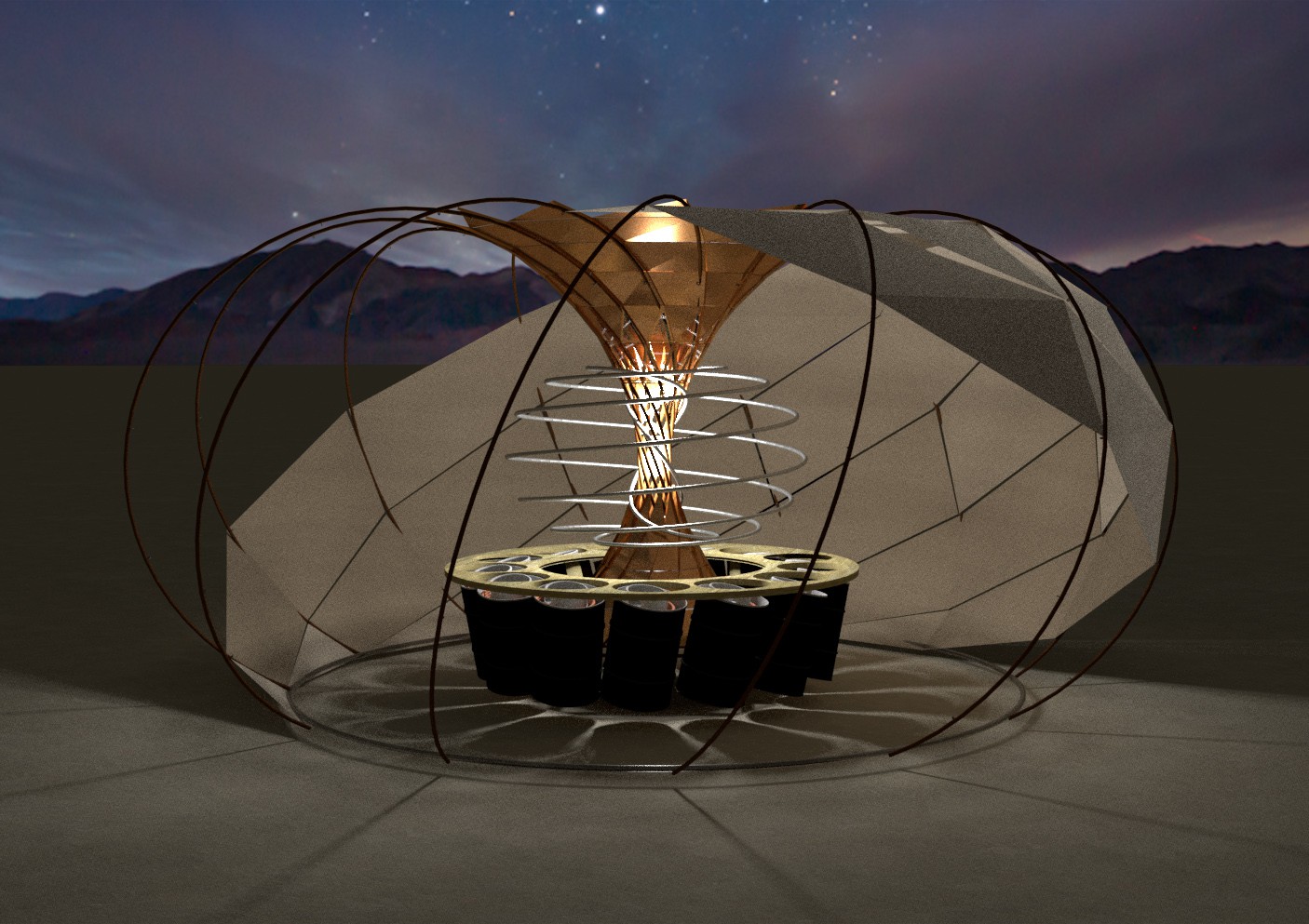
I spent some time diving into the detail work on my model (which is now available on the SketchUp 3D warehouse), and I really like what I've ended up with. It's admittedly more ambitious, but I always wanted to make this project a work of art, not just engineering.
I want to build something that embodies the energy flux of solar energy through living systems- a shrine to the chemical process of metabolism that makes all life possible. What better shape for that than a torus?
It also doesn't hurt that I built a 30' toroidal steel pavilion for a Burning Man art project in 2016, which has been pickling in playa dust under my porch for the past two winters, and has developed a very nice rusted patina.

In fact, most of the components of this new system are cobbled together from bits and part I already have from older projects (seems appropriate). I've already got a Harbor Freight trailer, a 30' toroidal structure made up of twelve 1" steel 6' radius rings that break down into 10' sections, a 4500W propane powered generator I scored on Craigslist for $40, and about 100' of 1" stainless steel gas tubing I got at the Rebuilding Center for $6.
So I think I can put together an impressive installation for not that much money.
The basic idea is that the machine will use computer-controlled heating coils (Ni-Chrome or Induction) to heat up 5.5 gallon kegs that are filled with compressed, shredded, and dried biomass, such as woodchips, yard waste, food scraps, and eventually even sorted non-recycleable or degraded plastics (HDPE, LDPE, and PP).
The application of heat in the absence of oxygen causes the hydrocarbons in the material to break apart and vaporize into smaller hydrocarbon chains, and escape from the keg in the form of a thick hot smoke. That smoke is directed into a series of stainless steel condensers (the smaller torus in the center of the structure), and as the smoke is pushed through this condenser it cools back down to ambient temperature, causing the hydrocarbons that make up the smoke to condense into liquids as they cool. These liquids drain back via gravity to the bottom of the torus, where they can be tapped off and collected to be refined into biofuels, or simply safely recirculated into the reactor.
After the gas has been cooled back to room temperature, the only 2 gasses that remain are Hydrogen (H2) and Carbon Monoxide (CO), both of which are invisible, odorless, colorless, and highly flammable. When introduced to oxygen, they readily combust into Carbon Dioxide and Water Vapor, releasing heat in the process. An interesting property of Syngas (which is what the mixture of CO and H2 is sometimes called) is that unlike propane (C3H8) or gasoline (C8H18) or other complex hydrocarbon fuels, Syngas is made up of such simple molecules that when it burns, it should not produce soot of any kind. You know that kind of wavy, perfectly clear, hot exhaust that jet engine makes? It should look like that.

And that's kind of a neat idea, I think, since people are (rightly) conditioned to not burn plastic or trash, because doing so without proper containment, condensation, and filtration IS very dirty and very toxic, and produces a toxic smoke. So the central hearth of the Metabolizer is designed to be made out of CNC-cut folded sheet metal polygons that glass panels will fit into, making the structure into 360 degree a viewing window that allows people to see the combustion going inside (which will hopefully take the form of a fire tornado). If the machine is built and operated properly, there should be no soot build up of any kind on the glass- which is sort of a showy way to prove to everyone that the machine is not releasing any toxic compounds into the air (Look ma, no VOCs!).
Speaking of Jet Engines, I am suspicious that the two cones that make up the inside of the torus could be made into a sort of low-pressure jet engine, with fans at the top and bottom controlled by E-bike hub motors, which can act as both motors and generators. The bottom fan pushes fresh air into the combustion zone at the center, where it meets the gas and combusts, which causes it to expand and spin the rotor suspended above it, producing baseline electrical power for the machine without having to run a noisy internal combustion engine all the time.
So, if you happen to be an engineer specializing in jet engines... Let's talk. Otherwise, stay tuned, and if you would like to be involved on this project, please contact me!
 Sam Smith
Sam Smith
Discussions
Become a Hackaday.io Member
Create an account to leave a comment. Already have an account? Log In.